Recession to blame for unwanted horse problem
The economy is the No. 1 reason for a dramatic increase in the number of unwanted horses.
WASHINGTON — The economic recession is the No. 1 reason for a dramatic increase in the number of unwanted, abused and neglected horses nationwide.
That's the clear consensus of thousands of persons who responded online to the 2009 Unwanted Horse Survey sponsored by the Unwanted Horse Coalition (UHC), a group formed in 2006 to collect information and raise awareness of the problem.
The closing of the last three U.S. horse-processing plants in the United States in 2007 ranked as the No. 2 leading cause, although there was disagreement among survey subgroups on the role of those plants, past and future.
The UHC, which operates under the American Horse Council (AHC) in Washington, recently published a 36-page breakdown of the survey results on its Web site, www.unwantedhorsecoalition.org.
"The response was greater than anyone anticipated when the survey site went live in November 2008," the UHC says in a summary statement. "By the end of the first day, nearly 500 respondents had completed the survey. In a matter of weeks, there were 27,000 more responses and thousands of write-in comments."
It has taken more than six months to compile, evaluate and publish the findings.
Aside from the economy and closing of the processing plants, the survey ranked change in breed demand/indiscriminate breeding as the No. 3 contributing factor and the high cost of euthanasia as No. 4.
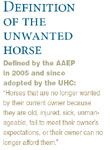
Definition of the unwanted horse
"Economics is the most common reason a horse becomes unwanted," the survey states. With the average cost of horse ownership estimated at $1,500 to $2,000 a year, many owners, especially those who have lost jobs and income, say they no longer can afford them and have limited options for what to do with them.
The survey provided two questionnaires — one for horse owners and one for industry stakeholders.
By far the largest group of responses, 20,484, came from the "owner" questionnaire. It included responses from 422 non-owners — persons who currently don't own a horse but know or are related to an owner, previously owned a horse or are friends of the horse industry/community.
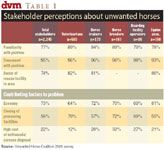
Table 1 Stakeholder perceptions about unwanted horses
Those who answered the "stakeholder" questionnaire included 2,245 professionals involved in the horse industry or who have contact with it. Equine veterinarians (593) made up the largest segment of stakeholders. Others included horse breeders, trainers, facility operators, owners and managers of rescue and adoption facilities, directors and staff members of equine associations and others.
While horse owners and most stakeholders say closing of the processing plants is a big contributor to the problem and favor reopening them, most associated with rescue/retirement groups strongly oppose such facilities and say their closing was at best a secondary contributing factor.
Public perception that unwanted horses are a problem has grown dramatically over the last three years, the survey shows. In 2006, only about 20 percent of all those surveyed believed unwanted horses were a serious problem. Today, 80-plus percent of them do.

Table 2 Primary responsibility for solving problem
Familiarity with the issue and its seriousness is highest among veterinarians and breeders, at 89 percent each, followed by other stakeholder groups.
The survey says the problem in 2009 is not only perceived to be increasing significantly, but the detrimental effects are being felt in all states.
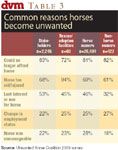
Table 3 Common reasons horses become unwanted
Among the more disturbing survey observations is a dramatic rise in horse neglect, abandonment and abuse, trumpeted by hundreds of write-in comments from across the country such as these:
» "Left to starve, abandoned by owners"
» "Turned out in the wild, and even along freeways"
» "Tied to a stranger's trailer"
» "Let loose to die in the woods"
» "Left to run wild or to die by the roadside"
» "Starved to death"
» "Abandoned, left to die without food or water"
» "Horses are being dropped off at auctions"
» "Horses are showing up on public lands."
As chairman of the UHC, Tom Lenz, DVM, MS, Dipl. ACT, of Louisburg, Kan., has made numerous presentations on the issue, most recently at the AHC annual convention in Washington. "Three or four years ago, there wasn't a lot of talk about it, but nowadays there's so much interest I could give a speech about it every day," Lenz told DVM Newsmagazine at last year's American Association of Equine Practitioners (AAEP) convention.
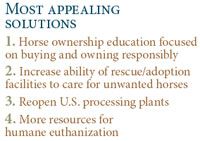
Most appealing solutions
With the exception of rescue/adoption facilities, all survey groups cited horse owners as having the primary responsibility for solving the unwanted-horse problem, followed closely by horse breeders. Persons associated with rescue facilities say breeders and equine associations are most responsible, followed by owners.
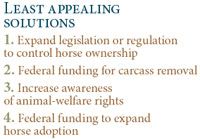
Least appealing solutions
The survey found that horse rescue/adoption facilities currently are turning away 38 percent of the horses brought to them, that 39 percent of them are at maximum capacity and 30 percent are at 75 percent to 99 percent of capacity.
With an average annual budget of $2,300 needed to care for one horse, the industry says it would need $25.7 million just to care for horses that currently are being turned away.
Of several solutions proposed, these four ranked as the "most appealing" by survey respondents:
» Educate owners to purchase and own responsibly
» Increase the ability of private rescue/retirement facilities to care for unwanted horses
» Reopen U.S. processing plants (Montana recently passed a law to allow them, and several other states are considering it.)
» Increase options and resources for euthanization.